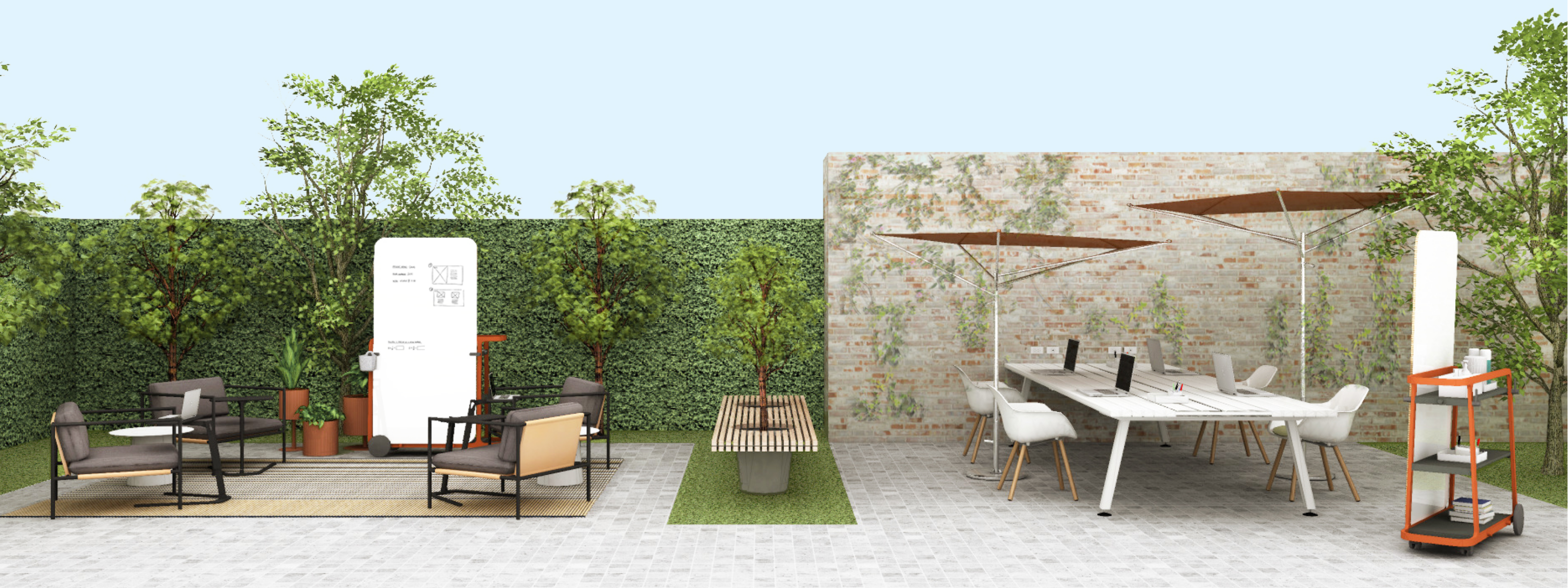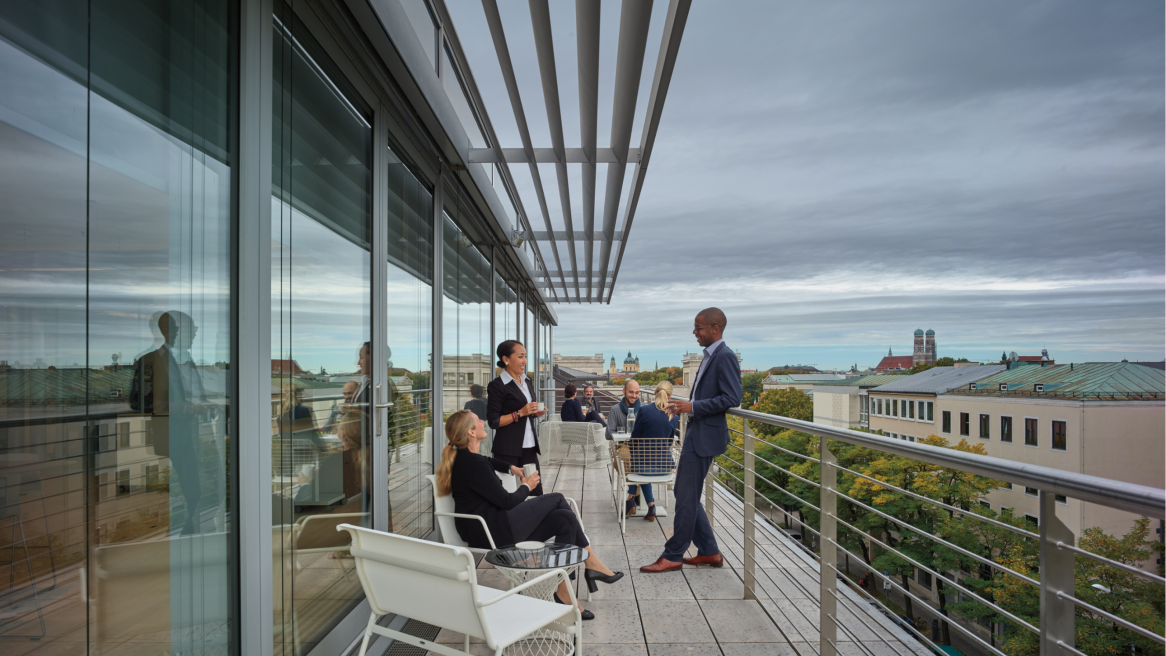This article is part of a series of updates to “Navigating What’s Next: The Post-COVID Workplace.”
Outdoor working, much like outdoor dining, is in high demand as employees begin returning to the office in parts of the world. Organizations are implementing a wide range of measures to help create safe workplaces — and to help employees feel safe. As improved ventilation becomes a key strategy for mitigating COVID-19 transmission, outdoor work areas offer a way for people to have the human interactions they crave to be productive.
“People love to be outside for all kinds of reasons, but often the spaces at work are designed for social interactions, like having lunch outside, or respite,” says Mary Elaine Roush, Steelcase applications design manager. “But it’s possible to create productive outdoor workspaces where people can benefit creatively and feel safe.”
Outdoor work areas offer a safe way for people to have human interactions they crave to be productive.
Working Al Fresco
People eager to work together again have been scheduling outdoor meetings in parks, parking lots and other outdoor spaces. While these outdoor sessions offer a welcome alternative to exhausting video meetings it can be tough to be productive in a lawn chair. Leading companies have been experimenting with outdoor work environments to increase employee engagement and improve attraction and retention, but now they’re even more important to help employees work from the office again.
In August 2019, LinkedIn opened an experimental outdoor workspace in Sunnyvale, CA that’s not just meant for dining or social connections. The pilot space supported by Extremis, a Steelcase partner, is designed for heads-down work. A 17 foot-long central, shared picnic-style work table with permanent no-glare monitors, adjustable height chairs and retractable overhead shades create high performing and inspiring spaces where people want to work.
The outdoor office test environment at LinkedIn’s Sunnyvale, CA campus (photographed in 2019) is designed for more than just dining or social connection. It’s designed for people to get heads-down work done.
LinkedIn photographer Tony Chung
Benefits of Creating Outdoor Workspaces
Outdoor workspaces can help organizations re-establish a sense of community for people who have been working from home for months. Comfortable outdoor meeting spaces give people a place to connect with nature, and reduce stress to counter mental fatigue.

Tips for Designing Outdoor Workspaces
Keep a 6ft/2m physical distance. Just because people are outside doesn’t mean they should forget about protocols while collaborating, working alone, socializing or taking a break. Seating needs to be intentional to create physical distancing between users.
Offer a range of spaces to accommodate multiple work modes: besides conversations, solo work and social connections, outdoors spaces can support collaborative meetings or larger team stand-ups.
Outdoor power solutions are critical. Place furniture near power, when possible. Staying plugged in and fully charged is crucial to being able to work outside.
Rugs and floor patterns can help with wayfinding and communicate appropriate circulation paths.
Protect people from the sun — and help them see their computer screens — with trees, umbrellas or shades.
Use flexible furniture pieces, such as small ottomans or stools that can be easily moved, allowing more people to join a meeting while staying distanced. They can also serve double-duty as side tables. Stick with light colors to minimize the heat absorbed by the furniture.
Use seating designed for work that supports a variety of postures. Avoid using lawn chairs that can lead to bad posture and discomfort.
Elements such as parasols or planters can create personal boundaries and act as friendly barriers between settings.
Consider including heaters or fireplaces to extend the use of outdoor spaces when the weather gets cooler.
Add worksurfaces such as personal tables to lounge areas to support computers at the proper ergonomic height. This can also function as a visual cue to indicate the amount of people allowed in the seating area.
In-person interactions can be supported at long linear tables where people can sit diagonally across from each other to create a good social experience without breaking physical distancing recommendations.
Featured Products
Steelcase Flex Team Cart
Steelcase Flex Markerboard
Extremis Marina Double Desk
Extremis Captain’s Chair
Extremis Acacia Shade
Bring mobile whiteboards and carts outside temporarily to provide people with the tools they need for successful collaboration. Include cleaning supplies for cleaning worksurfaces and tools.
Featured Products
Blu Dot Perch Outdoor Lounge Chair
Coalesse Free Stand
Steelcase Flex Team Cart
Steelcase Flex Markerboard
Coalesse nanimarquina Mesh Rug
Extremis Romeo & Juliet Bench
Blu Dot Plot Planters
The Steelcase Flex Collection and Coalesse Free Stand are not tested for outdoor use and should not be left outside beyond the duration of your meeting or working session.
Outdoor Portfolio
Steelcase and its family of brands and partners has an extensive portfolio of products from which to choose to create safe and compelling outdoor spaces. Browse examples of some outdoor workspaces to help you get ideas for your office.


